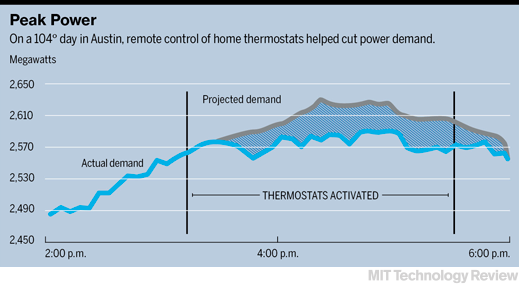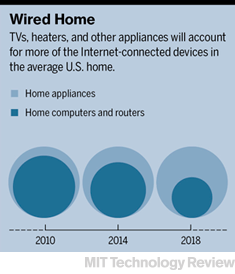The Lowly Thermostat, Now Minter of Megawatts
Google’s $3.2 billion acquisition of Nest Labs in January put the Internet of things on the map. Everyone had vaguely understood that connecting everyday objects to the Internet could be a big deal. Here was an eye-popping price tag to prove it.
Nest, founded by former Apple engineers in 2010, had managed to turn the humble thermostat into a slick, Internet-connected gadget. By this year, Nest was selling 100,000 of them a month, according to an estimate by Morgan Stanley.
At $249 a pop, that’s a nice business. But more interesting is what Nest has been up to since last May in Texas, where an Austin utility is paying Nest to remotely turn down people’s air conditioners in order to conserve power on hot summer days—just when electricity is most expensive.
For utilities, this kind of “demand response” has long been seen as a killer app for a smart electrical grid, because if electricity use can be lowered just enough at peak times, utilities can avoid firing up costly (and dirty) backup plants.
Demand response is a neat trick. The Nest thermostat manages it by combining two things that are typically separate—price information and control over demand. It’s consumers who control the air conditioners, electric heaters, and furnaces that dominate a home’s energy diet. But the actual cost of energy can vary widely, in ways that consumers only dimly appreciate and can’t influence.

While utilities frequently carry out demand response with commercial customers, consumers until now have shown little interest. Nest Labs’ breakthrough was to make a device that has popular appeal. “There’s a lot of digital Internet thermostats out there, but Nest was able to create a concept around it. They’ve created something that people are relating to,” says Mary Ann Piette, a demand response expert and head of the Building Technology and Urban Systems Department at Lawrence Berkeley National Laboratory.
Once inside a home, Nest starts its real work: gathering data. It has motion detectors; sensors for temperature, humidity, and light; and algorithms that learn residents’ habits and preferences and can program heating and AC settings. A Wi-Fi connection brings in weather data and allows consumers to control the system with a phone or Web browser.
Data is just the start. Just as Google parlays what it knows about you into tools for advertisers on the Web, Nest is using its capabilities to create new types of services for utilities to buy. “We can go to utilities and say, ‘We’ve actually got a lot of customers in your service territory who already have a Nest,’” says Scott -McGaraghan, Nest Labs’ head of energy products. “And [then we] can flip it on.”

Austin’s municipal utility, Austin Energy, is one of five utilities that have signed up for Nest Labs’ Rush Hour Rewards, as the service is called. Air conditioners account for half of Texas’s electricity demand on hot days, and that demand for cooling drives the wholesale cost of electricity from less than $40 per megawatt-hour to well over $1,000.
Twelve months ago Austin Energy started offering a one-time $85 rebate to customers who agreed to let it automatically trim their air-conditioning using smart thermostats sold by Nest and other companies. Each company earns $25 for every thermostat it enrolls, and another $15 per thermostat each year after that.
Once inside a home, Nest starts its real work: gathering data. It has a motion detector; sensors for temperature, humidity, and light; and algorithms that learn residents’ habits and preferences.
The “vast majority” of the 5,500 thermostats registered so far are Nests, according to Sarah Talkington, the Austin Energy engineer leading the program. Nest says it finds that roughly half its customers will sign up for demand response when the opportunity is offered.
By the end of last summer, Talkington says, she could log on to a Nest portal and, with a few keystrokes, dial down the next day’s demand by nearly 5.7 megawatts. That may seem small compared with the 2,800 megawatts that often sizzle across the Austin grid, but every watt counts. On hot days like September 3, 2013, as temperatures rose to 104 °F, the cost of power spiked to a record $4,900 per megawatt-hour.
Austin had tried residential demand response before, using one-way pagers to turn air conditioners on and off. But the utility couldn’t know if customers were home, so it wasn’t able to shut off any one air conditioner for long. Nest, in contrast, builds a thermal model of each house and predicts how quickly it will warm up. It can also guess whether people will be home. The result, says McGaraghan, is that Nest can maximize energy savings and minimize annoyance to residents.

Talkington predicts the residential program will enroll enough homes to save more than 13 megawatts through demand response this summer. Even if Austin gives out $2 million in rebates, that is cheaper than increasing power supply by building a natural-gas-fired generator. According to Michael Webber, co-director of the clean-energy incubator at the University of Texas in Austin, new power supply costs $500,000 to $4,000,000 per megawatt of capacity, depending on the type of plant.
Webber believes that within five years the “vast preponderance” of Texans will have smart thermostats. And Nest knows that whoever builds this network first could win big, especially as other energy-consuming devices, like electric cars and hot-water heaters, also get wired up.
Eventually, the effects of demand response could be profound. Austin’s program is designed to manage demand only during the 50 hours each year when electricity consumption tests the grid’s limits most. But if demand response can expand to cover the 300 or 400 hours of peak usage, it could entirely shut down the market for “peakers,” or gas-fired plants that come online only to sell expensive electricity. “That’s a big chunk of money that’s at stake,” says Tom Osterhus, CEO of Integral Analytics, a Cincinnati-based maker of smart-grid analytics software. “It’s in the billions.”
Keep Reading
Most Popular
Large language models can do jaw-dropping things. But nobody knows exactly why.
And that's a problem. Figuring it out is one of the biggest scientific puzzles of our time and a crucial step towards controlling more powerful future models.
The problem with plug-in hybrids? Their drivers.
Plug-in hybrids are often sold as a transition to EVs, but new data from Europe shows we’re still underestimating the emissions they produce.
Google DeepMind’s new generative model makes Super Mario–like games from scratch
Genie learns how to control games by watching hours and hours of video. It could help train next-gen robots too.
How scientists traced a mysterious covid case back to six toilets
When wastewater surveillance turns into a hunt for a single infected individual, the ethics get tricky.
Stay connected
Get the latest updates from
MIT Technology Review
Discover special offers, top stories, upcoming events, and more.